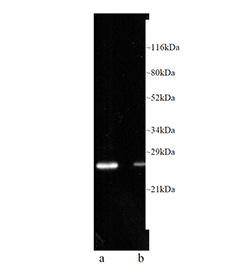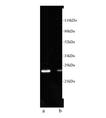Product Details
| Alternative Name: | Proteasome subunit β type-8, LMP7, RING10 protein, Macropain subunit C13 |
| |
| Clone: | LMP7-1 |
| |
| Host: | Mouse |
| |
| Isotype: | IgG1 |
| |
| Immunogen: | Recombinant human proteasome subunit β5i. |
| |
| UniProt ID: | P28062 |
| |
| Gene/Protein Identifier: | PSMB8 (gene name), 5696 (Entrez Gene ID) |
| |
| Source: | Purified from ascites. |
| |
| Species reactivity: | Human, Rat
|
| |
| Specificity: | Recognizes the β5i subunit of proteasome 20S. |
| |
| Applications: | IHC, WB
|
| |
| Application Notes: | The serum was characterised by single dimension SDS-PAGE using a HeLa cell lysate both with and without prior stimulation with γ-interferon. The mature LMP7 protein giving a band at a relative molecular weight of ~25kDa was detected by Western blotting in both stimulated and nonstimulated cells.
Not suitable for immunoprecipitation. |
| |
| Purity Detail: | Protein G affinity purified. |
| |
| Formulation: | Liquid. In PBS, pH 7.4, containing 10mM sodium azide. |
| |
| Shipping: | Blue Ice |
| |
| Long Term Storage: | -20°C |
| |
| Scientific Background: | The proteasome is widely recognised as the central enzyme of non-lysosomal protein degradation. It is responsible for intracellular protein turnover and it is also critically involved in many regulatory processes and, in higher eukaryotes, in antigen processing. The 26S proteasome is the key enzyme of the ubiquitin/ATP-dependent pathway of protein degradation. The catalytic core of this unusually large (2000kDa, 450Å in length) complex is formed by the 20S proteasome, a barrel shaped structure shown by electron microscopy to comprise of four rings each containing seven subunits. Based on sequence similarity, all fourteen 20S proteasomal subunit sequences may be classified into two groups, α and β, each group having distinct structural and functional roles. The α-subunits comprise the outer rings and the β-subunits the inner rings of the 20S proteasome. Observations of the eukaryotic proteasome and analysis of subunit sequences indicate that each ring contains seven different subunits (α7β7β7α7) with a member of each sub-family represented in each particle. Each subunit is located in a unique position within the α- or β-rings. Lmp2, Lmp7 and MECL are interferon gamma-inducible catalytic subunits of the 20S proteasome which may replace the constitutive catalytic subunits, delta, X and Z respectively, during proteasome biogenesis. Lmp2 and Lmp7 alter the cleavage site specificity of the 20S proteasome and are required for the efficient generation of T cell epitopes from a number of viral proteins and for optimal MHC class I cell surface expression . |
| |
| Technical Info/Product Notes: | Various systems for the nomenclature of the proteasome subunits have been established. This may be a source of confusion as the system on UniProt differs from "standard" nomenclature as described in the literature. The UniProt ID and Gene Name will help to clearly identify the proteins. |
| |
| Regulatory Status: | RUO - Research Use Only |
| |

Western blot analysis: Luminograph of HeLa cell lysates with (a) and without (b) prior stimulation with γ-interferon after SDS-PAGE followed by blotting onto PVDF and probing with antibody Prod. No. BML-PW8845.
Please mouse over
Product Literature References
Protective effects of cannabidiol on the membrane proteins of skin keratinocytes exposed to hydrogen peroxide via participation in the proteostasis network: S. Atalay, et al.; Redox Biol.
46, 102074 (2021),
Abstract;
Comparative evaluation of CacyBP/SIP protein, β-catenin, and immunoproteasome subunit LMP7 in the heart of rats with hypertension of different etiology: I, Kasacka, et al.; Exp. Biol. Med. (Maywood)
243, 1199 (2018),
Abstract;
A therapeutic T cell receptor mimic antibody targets tumor-associated PRAME peptide/HLA-I antigens: A.Y. Chang, et al.; J. Clin. Invest.
127, 2705 (2017),
Abstract;
Full Text
Detection of active proteasome structures in brain extracts: proteasome features of August rat brain with violations in monoamine metabolism: P.A. Erokhov, et al.; Oncotarget
8, 70695 (2017),
Abstract;
Full Text
Adaptive response activated by dietary cis9, trans11 conjugated linoleic acid prevents distinct signs of gliadin-induced enteropathy in mice: P. Bergamo, et al.; Eur. J. Nutr.
55, 729 (2016),
Abstract;
Interferon-dependent immunoproteasome activity during mouse adenovirus type 1 infection: M.K. McCarthy, et al.; Virology
498, 57 (2016),
Abstract;
Full Text
The immunoproteasome β5i subunit is a key contributor to ictogenesis in a rat model of chronic epilepsy: M. Mishto, et al.; Brain Behav. Immun.
49, 188 (2015),
Application(s): Immunohistochemistry,
Abstract;
Ubiquitin-independent proteosomal degradation of myelin basic protein contributes to development of neurodegenerative autoimmunity: A. Belogurov Jr, et al.; FASEB J.
29, 1901 (2015),
Abstract;
Full Text
Purification and separation of the 20S immunoproteasome from the constitutive proteasome and identification of the subunits by LC-MS: V. Dechavanne, et al.; Protein Exp. Purif.
87, 100 (2013),
Application(s): Western blot,
Abstract;
Immunoproteasome expression is induced in mesial temporal lobe epilepsy: M. Mishto, et al.; Biochem. Biophys. Res. Commun.
408, 65 (2011),
Application(s): Immunohistochemistry and Western blot,
Abstract;
TRIM5α associates with proteasomal subunits in cells while in complex with HIV-1 virions: Z. Lukic, et al.; Retrovirology
8, 93 (2011),
Abstract;
Full Text
Studies on immunoproteasome in human liver. Part I: absence in fetuses, presence in normal subjects, and increased levels in chronic active hepatitis and cirrhosis: F. Vasuri, et al.; Biochem. Biophys. Res. Commun.
397, 301 (2010),
Application(s): Immunohistochemistry and Western blot,
Abstract;
The proteasome load versus capacity balance determines apoptotic sensitivity of multiple myeloma cells to proteasome inhibition: G. Bianchi, et al.; Blood
113, 3040 (2009),
Application(s): Immunofluorescence and Western blot,
Abstract;
Full Text












